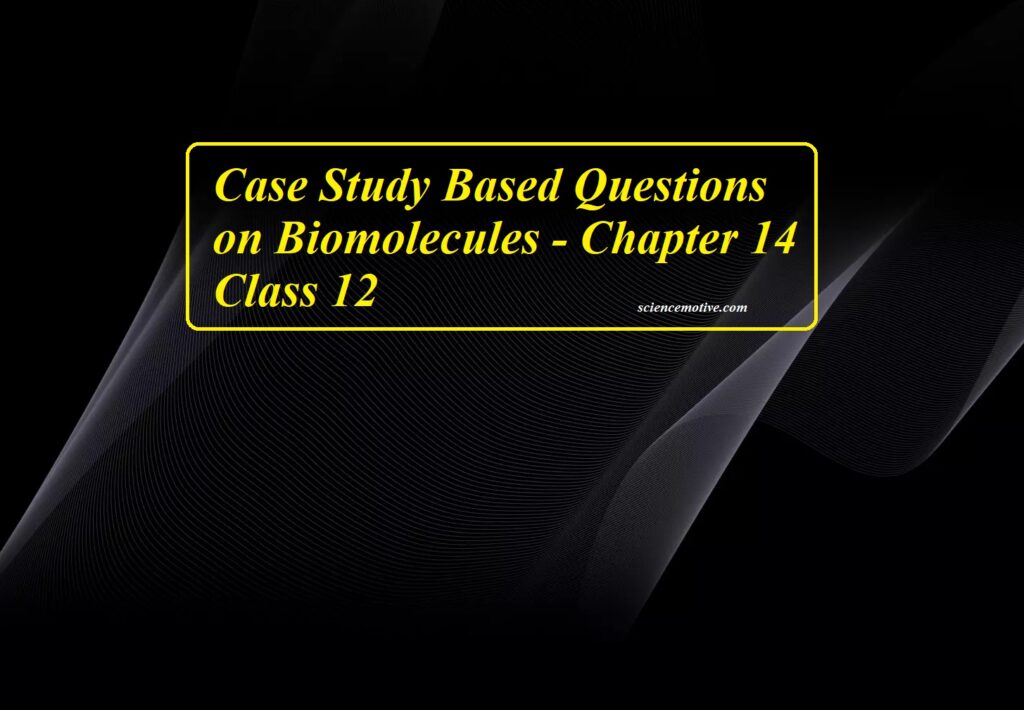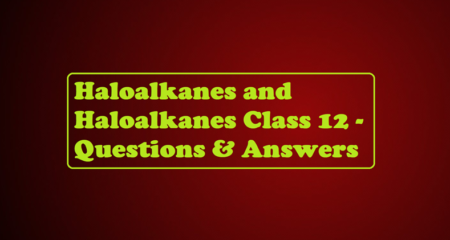Case Study Based Questions on Biomolecules
Case Study Based Questions on Biomolecules
1. Read the given passage and answer the questions that follow
Monosaccharides containing an aldehyde group are called aldoses while those containing a keto group are called ketoses. All monosaccharides containing five and six carbon atoms have cyclic structures, furanose (five-membered) and pyranose (six-membered). During ring formation, C1 aldoses and C2 in ketoses becomes chiral and hence all these monosaccharides exist in two forms called the α-anomer and β-anomer while C1 and C2 are called glycosidic or anomeric carbon atoms. In contrast, stereoisomers, which differ in configuration at any other chiral carbon other than the glycosidic carbon are called epimers. Two molecules of the same or different monosaccharides combine together through glycosidic linkage to form disaccharides
Que 1. Which of the following compounds show furanose structures?

a) Mannose
b) Galactose
c) Fructose
Ans 1. (c)
Que 2. What is the relation between two molecules?
(a) Enantiomers
(b) Epimers
(c) Functional groups
(d) Anomers
Ans 2. (b)
Que 3. In disaccharides, the linkage connecting monosaccharide units is called
(a) Glycogen linkage
(b) Nucleoside linkage
(c) Glycosidic linkage
(d) Peptide linkage.
Ans 3. (c)
2. Read the given passage and answer the questions that follow
The sequence of bases in mRNA is read in serial order in groups of three at a time. Each triplet of nucleotides (having a specific sequence of bases) is known as codon. Each codon specifies one amino acid. Many amino acids have more than one codons. The amino acids are brought to mRNA by another type of RNA called tRNA each amino acid has at least one corresponding tRNA. At one end of the tRNA is a trinucleotide base sequence on mRNA.
Que 1. Which of the following nitrogen bases is not present in RNA?
a) Thymine
b) Adenine
c) Guanine
d) Cytosine
Ans 1. (a)
Que 2. Each triplet of nucleotides is called
a) Anticodon
b) Codon
c) mRNA
d) tRNA
Ans 2. (b)
Que 3. Each codon specifies
a) 1 amino acid
b) 2 amino acids
c) 3 amino acids
d) None of these
Ans 3. (a)
Case Study based questions on Biomolecules
3. Read the given passage and answer the questions that follow
Proteins are the most abundant biomolecules of the living system. The chief sources of proteins are milk, cheese, pulses, fish, meat, peanuts, etc. They are found in every part of the body and form a fundamental basis of the structure and functions of life. These are also required for the growth and maintenance of the body. The word protein is derived from the Greek word, ‘proteios’ meaning ‘primary’ or of ‘prime importance’. Chemically, proteins are the polymers in which the monomeric units are the α-amino acids. Amino acids contain an amino (-NH2) and carboxylic (-COOH) functional groups. Depending upon the relative position of the amino group with respect to the carboxylic group, the amino acids can be classified as α, β, and γ-amino acids. Amino acids which are synthesised by the body are called non-essential amino acids. On the other hand, those amino acids which cannot be synthesized in the human body and are supplied in the form of diet (because they are required for proper health and growth) are called essential amino acids.
Que 1. Amino acids show amphoteric behavior. Why?
a) They have an amino group
b) They have a carboxylic group
c) Both (a) and (b)
d) none of the above
Ans 1. (c)
Que 2. The name of linkage joining two amino acids
a) Hydrogen bonding
b) Peptide linkage
c) Amino linkage
d) Imino joints
Ans 2. (b)
Que 3. What are polypeptides?
a) 10 < α-amino acids joined together
b) amino acids joined together
c) 20 < β-amino acids joined together
d) None of the above
Ans 3. (a)
Que 4. What type of bonding helps in stabilizing the α-helix structure of proteins?
a) Peptide linkage
b) Hydrogen bonding
c) Amino linkage
d) Van der waals force
Ans 4. (b)
Case Study based questions on Biomolecules
4. Read the given passage and answer the questions that follow
Biomolecules are complex molecules that build up living organisms and are required for their growth, maintenance, and ability to reproduce. Carbohydrates are polyhydroxy aldehydes and ketones which are major sources of energy. Monosaccharides are simple sugars that cannot be hydrolyzed. Oligosaccharides, on hydrolysis, give 2 to 10 molecules of monosaccharides. Polysaccharides like starch and cellulose on hydrolysis give a large number of molecules of glucose a-glucose and b-glucose (Anomers). Proteins are complex nitrogenous polymers of amino acids connected through peptide bonds. The sequence in which amino acids are linked is called Primary structure. Secondary structures are of 2 types a-helix in globular proteins and b-pleated structure in fibrous proteins involving H-bonds. The tertiary structure has H-bonds, disulphide linkage, ionic bonding, and van der Waals’ forces. Insulin is a hormone for the metabolism of glucose, has a quarternary structure. Denaturation of protein destroys a secondary and tertiary structure, loss of biological activity but primary structure remaining the same. Enzymes are highly specific, work at specific pH, moderate temperature, and catalyze biochemical reactions. Hormones perform specific functions and are secreted by endocrine glands. Vitamins are essential for a healthy body. A, D, E, K are fat-soluble vitamins. Vitamin C and B1, B2, B6 are water-soluble. B12 is neither water nor fat-soluble. Nucleic acids are polymers of nucleotides. RNA consists of m-RNA, t-RNA, r-RNA. RNA has Adenine, Cytosine, Uracil, and Guanine. It helps in protein synthesis. It cannot replicate. DNA contains deoxyribose, A, C, G, and Thymine. It transfers genetic characteristics. DNA has a double helix structure and undergoes replication.
Que 1. Name a disaccharide which on hydrolysis give glucose and galactose.
Ans 1. Lactose.
Que 2. What type of protein is albumin?
Ans 2. Globular protein.
Que 3. Name one non-reducing sugar.
Ans 3. Sucrose
Que 4. Which one is the complementary base of cytosine in one strand of DNA to that in another strand of DNA?
Ans 4. Guanine.
Que 5. Which linkage by which nucleotides are joined together between 5′ and 3′ atoms of pentose sugar?
Ans 5. Phosphodiester linkage.
Que 6. Which vitamin helps in the coagulation of blood?
Ans 6. Vitamin K.
Que 7. Which enzyme can dissolve blood clots to prevent a heart attack?
Ans 7. Streptokinase
Case Study based questions on Biomolecules



